It
is already evident that the
Moon will soon become a controversial object of different
interests from the earth. Issues of colonization and other types
of commercial exploration of our satellite are under serious discussion
in some countries, including Russia and the United States - pioneers
of the initial lunar exploration of the mid-20th century. It is
also evident that something very important and precious can be
derived from further exploration of the Moon, especially now,
when technologies are far more advanced than ever before in the
history of humankind. Recently, the US space agencies, such as
ESA, NASA, and NASDA, as well as the official Russian Space Agency,
have shown a highly elevated interest in new lunar programs, including
plans to establish a human lunar base. NASA intends to return
to the Moon in 2014 with a test flight of Orion spacecraft, while
its new manned lunar mission is scheduled for 2019. As for Russia,
there are plans to collaborate with China in a new wave of lunar
research, including sending robotic probes and manned expeditions
to the Moon in the near future. In addition, a European Meeting
on future space exploration, that was held in Athens in May 2007,
identified further close research of the Moon as one of the priority
issues of the coming space programs.
The
lunar plans of humankind are obvious, at least those, which are
aired for the general public. However, what do we really know
about the Moon and how does that ignite such a hot new interest
in further lunar research? Obviously, we know only what was made
public from the Luna and Apollo eras of lunar voyages. Both Soviet
and American lunar programs of the mid-20th century were space
ventures of a high level of secrecy, and only bits of information
were revealed for public use. Let us consider, for example, NASA.
It might be a civilian agency, however, most if its astronauts
and other employees have to obey strict military security regulations,
and most of NASA activities are funded from the defence budget.
NASA carefully screens and stores all images from the Moon and
keeps many of them, as well as some contradictory lunar artefacts,
in secret archives. Only a handful of images are open to the general
public, and only a part of lunar material and samples are available
outside of secret laboratories of NASA.
It
is admitted even by NASA officials that the Moon could hide a
possible presence of alien life. Big domes standing on mighty
basements, long lines of ruins, tunnels, and remnants of other
constructions of unknown origin, which were found on the surface
of the Moon, cannot be explained just by a play of natural forces,
due to their even and complex geometrical designs. If we look
closer at the artefacts scattered on landing sites of human lunar
modules and caught on camera, we can notice that some of them
resemble ruins of artificial constructions. Photographs from the
lunar orbit show terrific rectangular and square lines of once
geometrically designed formations that look like destroyed ancient
cities. Those structures with even patterns are located in the
areas of random geology and a chaotic landscape, as if they were
deliberately placed there. If they were not created by lunar aboriginals,
who placed them on the surface of the Moon? Numerous myths and
legends of different historical cultures and nations of our planet
speak of a gods' race that once populated the Earth. Could it
be that the lunar artefacts and constructions have terrestrial
origin and were created on the Moon by a human race that lived
long ago and was definitely more advanced than we are now? It
is interesting to add that we even do not know for sure the true
origin of the Moon. Samples of lunar and earth rocks and soils
reveal striking differences in their material and composition,
which fairly contradicts to the prevailing scientific hypothesis
of the "Big Whack" formation of the Moon. Who knows,
maybe our satellite once was a part of a planetary structure with
an advanced civilization originated somewhere deep in space, which
colonized the Earth and gave birth to modern human races many
thousands of years ago?
In
this connection, let us consider the issue of a lunar atmosphere,
as breathable air is the most critical thing to sustain protein
life forms as we know them. We are taught that the Moon does not
have air, or at least that the lunar atmosphere is too scarce
to breath. However, our current technologies of measuring an air
level on the lunar surface are not advanced enough to produce
unquestionable results. In the opinion of John Lear, an influential
UFO specialist, the Moon sustains quite a tangible, yet thin,
atmosphere, which is even suitable for short-term breathing!
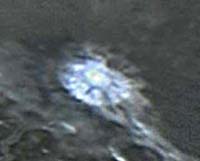 The
truth about the Moon is hidden, and some of it is hidden deliberately
from the public in secret laboratories of NASA and other space
agencies. Let us consider, say, a controversial enigma of much
debated lunar Aristarchus Crater.
Have you ever heard anything about it? Aristarchus Crater enigma
is one of numerous so-called Transient Lunar Phenomena (or TLP).
It is one of the brightest lunar occurrences, which changes colors,
sometimes producing a red or bluish glow of electricity, and emits
carbon gas. Among others, Aristarchus Crater's mysterious phenomena
were closely observed in 1958 The
truth about the Moon is hidden, and some of it is hidden deliberately
from the public in secret laboratories of NASA and other space
agencies. Let us consider, say, a controversial enigma of much
debated lunar Aristarchus Crater.
Have you ever heard anything about it? Aristarchus Crater enigma
is one of numerous so-called Transient Lunar Phenomena (or TLP).
It is one of the brightest lunar occurrences, which changes colors,
sometimes producing a red or bluish glow of electricity, and emits
carbon gas. Among others, Aristarchus Crater's mysterious phenomena
were closely observed in 1958 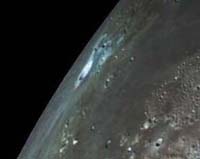 by
Russian astronomer N. Kozyrev and were reported by the crew of
Apollo 11. No one really knows what it is, but the nature of the
Crater's activities gives grounds to the theory that it could
be some sort of a power device, possibly, a fusion reactor. It
is interesting to point out that the Soviets had conducted a number
of observations and research of Aristarchus Crater, and in 1950
came out with an invention of the first fusion generator, called
Tokamak... However, the Aristarchus Crater phenomenon still remains
an unexplained lunar mystery. by
Russian astronomer N. Kozyrev and were reported by the crew of
Apollo 11. No one really knows what it is, but the nature of the
Crater's activities gives grounds to the theory that it could
be some sort of a power device, possibly, a fusion reactor. It
is interesting to point out that the Soviets had conducted a number
of observations and research of Aristarchus Crater, and in 1950
came out with an invention of the first fusion generator, called
Tokamak... However, the Aristarchus Crater phenomenon still remains
an unexplained lunar mystery.
The
most frequent official explanation of terrific TLP is attributed
to "astronauts' wild imagination", which, of course,
does not explain anything. Numerous astronauts' reports of strange
lunar "fleeting clouds", "flashes", and other
brief changes of light and colour on the Moon's surface are just
ignored by officials, or at least not covered much is the mass
press. However, in 1968, just a year before Neil Armstrong first
stepped onto the Moon, a NASA catalogue of TLP was published.
That document featured almost six hundred unexplained lunar occurrences,
which had been observed since the pre-telescopic year of 1540.
The catalogue included the 1871 - 1896 reports from England's
Royal Astronomical Society members, who observed lighted geometrical
images on the Moon, later confirmed observations of oval moving
lunar objects, and astronomers' reports on bridge-like constructions
in the area of Mare Crisium. The NASA catalogue also mentioned
a big and shiny cylindrical object that both Soviet and American
researchers saw upon the surface of the Moon in 1958. By publishing
that unprecedented set of documented evidence, NASA clearly acknowledged
that the Moon might not be a dead world, but, actually, could
be a cosmic body with some potentially dangerous and unknown phenomena.
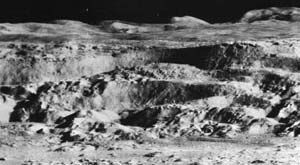 Later
on, observations of unusual lunar occurrences became even more
numerous. One of them, a huge lunar enigma, is hidden in Copernicus
Crater anomalies. The site appears to resemble an ancient, or
even a currently operating, strip mine. As the Moon lacks wind,
air and water, the soil erosion cannot be involved in producing
such a landscape, which reminds of a vast mining operation site
with debris and rock piles and angled terraces. Numerous details
of Copernicus Crater, such as ridges and mining ramps, look exactly
like those of earth strip mines. Closer observations of the Crater
photos reveal other phenomena, such as vapours of dust or smoke
and shapes of buildings, platforms, giant excavators, village
sites, and even an archway system. Terrific, indeed! Later
on, observations of unusual lunar occurrences became even more
numerous. One of them, a huge lunar enigma, is hidden in Copernicus
Crater anomalies. The site appears to resemble an ancient, or
even a currently operating, strip mine. As the Moon lacks wind,
air and water, the soil erosion cannot be involved in producing
such a landscape, which reminds of a vast mining operation site
with debris and rock piles and angled terraces. Numerous details
of Copernicus Crater, such as ridges and mining ramps, look exactly
like those of earth strip mines. Closer observations of the Crater
photos reveal other phenomena, such as vapours of dust or smoke
and shapes of buildings, platforms, giant excavators, village
sites, and even an archway system. Terrific, indeed!

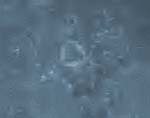 Another
riddle of the Moon is its Ukert Crater - one of the most obvious
lunar phenomena of visibly artificial origin). The crater has
an unusual triangular shape and its form remains unexplained.
And what about the Shard, that was first photographed by the Apollo
mission? The photographed object of a spindly geometrical shape Another
riddle of the Moon is its Ukert Crater - one of the most obvious
lunar phenomena of visibly artificial origin). The crater has
an unusual triangular shape and its form remains unexplained.
And what about the Shard, that was first photographed by the Apollo
mission? The photographed object of a spindly geometrical shape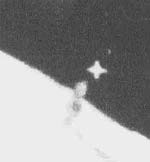 with some regular patterns is about 1 mile long and rises above
the surface of the Moon. By analyzing the reflection of sunlight
from the construction, researched have concluded that the Shard
cannot be composed of a natural substance. The construction could
be made of artificially-created polished metallic blocks and huge
glass crystals. Also, it has to be noted that there is no natural
force that can produce such an object and, if it is of natural
origin, then the Shard is one of the greatest wonders of the entire
Universe. Most probably, the Shard represents a partially eroded
and artificially constructed ancient structure.
with some regular patterns is about 1 mile long and rises above
the surface of the Moon. By analyzing the reflection of sunlight
from the construction, researched have concluded that the Shard
cannot be composed of a natural substance. The construction could
be made of artificially-created polished metallic blocks and huge
glass crystals. Also, it has to be noted that there is no natural
force that can produce such an object and, if it is of natural
origin, then the Shard is one of the greatest wonders of the entire
Universe. Most probably, the Shard represents a partially eroded
and artificially constructed ancient structure.
There
are many more unexplained lunar images, and we can only guess
what they mean and who erected those mighty structures and created
those fantastic Moon's TPL. Was the Moon a base of an ancient
civilization or a prehistoric colony, or maybe it was a giant
plant, an observatory, or a spacecrafts' launch site? Who knows,
what if the Moon is still alive, but that life prefers to be hidden
from us? Let us hope that future voyages to the Moon will reveal
some of those still unexplained lunar mysteries!
©
2007 Lunacorp.com
|

